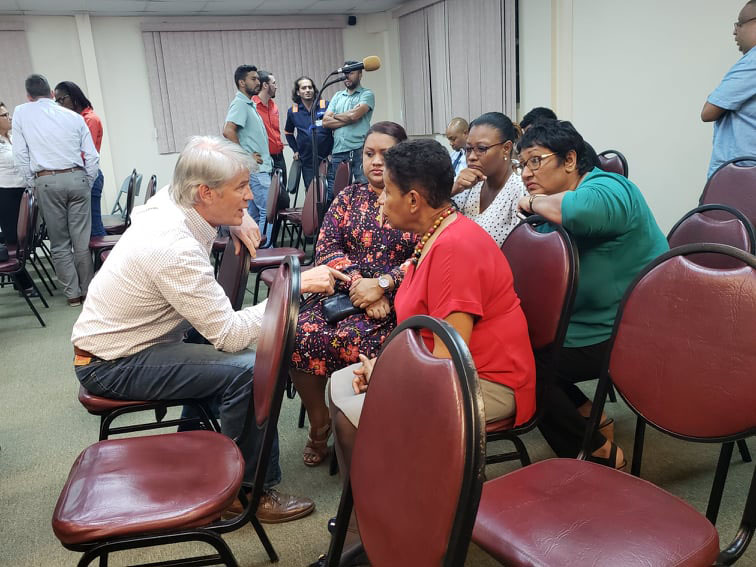Oil services company Nalco Champion has ceased all chemical warehousing plans at its Ruimveldt site following a visit by the Environmental Protection Agency (EPA) to the location.
Nalco’s plans for the storage of chemicals for eventual transfer to the offshore Floating Production Storage and Offloading (FPSO) oil platform has triggered protests from residents amidst concerns about possible dangers to nearby communities.
Nalco on Thursday revealed during a meeting at the New Guyana School, in South Ruimveldt, that it has ceased all operations at Industrial Site, Ruimveldt. The meeting was held by Nalco to address concerns raised by members of the public.
Jeremy Fernandes of John Fernandes Ltd (JFL) told the meeting that during one of their visits to the chemical warehousing facility at the JFL Inland Terminal, at 4055 Indus-trial Site, Ruimveldt, the EPA raised concerns surrounding the Environmental Impact Assessment (EIA) to be done, after which the two sides mutually agreed that Nalco would cease all operations pending the outcome of the EIA.
Fernandes further explained that JFL has permission to use the area as a storage facility, however, it was not specified what materials should be stored at the facility. He said he hoped Thursday’s meeting would alleviate some of the concerns of the residents. However, only a few residents attended though several dozen had participated in a press conference and protest against the warehouse on Saturday at Industrial Site.
The Supply Manager of Nalco, Eric Scott, told the attendees at Thursday’s meeting that the warehouse will be used strictly for storage of products and equipment along with repackaging of chemicals into tanks and for filtering chemicals.
“It will be strictly a warehouse and container facility,” Scott assured. He also said that the company will not be manufacturing chemicals. Chemicals are to be transported from Texas to the chemical warehouse, where they would be filtered before being taken to the FPSO.
In addition, he said that they will not be manufacturing any chemicals at the facility nor will there be any chemical reactions, vapour clouds or steam or any burying of chemical tanks. It was also stated that the company will not be dealing with gas, “strictly liquid.”
Operations with liquids would carry an inherent risk of spills and this would be one of the areas that the EIA would have to address.
During a presentation, Scott stated that the planned facility is safe and will meet or exceed all environment and safety requirements. He assured attendees that the company will conduct its operations safely and in compliance with all environmental regulations.
Country Readiness Manager John Waldvogel added that the company’s first and main concern is the health and safety of the environment and surrounding residents. He said that the company has several warehouses similar to the one they are proposing to build on the JFL Inland Terminal.
Cornerstone
“Safety is the cornerstone of everything that we do and truly no job, task is more important than safety,” he added. He went on to say that their manufacturing warehouse in Houston, Texas, is surrounded by churches, baseball stadiums and houses.
He stated that there will be personal protection equipment onsite in addition to 24-hour security and an eight-foot fence with barbed wire on top will also be built around the property. He said that there will also be a 1,000 square metre containment pad where all operations will be done. Numerous fire extinguishers will be spaced 15 metres apart.
“We have those equipment because it’s not only an internal policy for us but because that’s our first responsibility,” he stressed. Additionally, training will also be done on fires since all the chemicals which will be stored at the facility are flammable. He also said that should an incident occur, they have the equipment onsite to respond swiftly.
When asked by an attendee about the risk of transporting chemicals on the road, Waldvogel said that six or eight tanks would be moved on vehicles during the night. He also noted that the Guyana Police Force has agreed to escort the vehicles when they are transporting the chemicals. Scott added that the tank that the company will be using is one of the safest tanks in the world and meets International standards.
Nalco’s plan came to public notice on July 3rd in an EPA advertisement where it was disclosed that it was seeking authorisation to operate a chemical warehouse facility at Ruimveldt Industrial Estate.
According to the Notice, Nalco had submitted an application to the Agency for Environmental Autho-risation for the operation of a chemical warehousing facility at the JFL Inland Terminal at Ruimveldt, and the transportation of chemicals from the Inland Terminal to John Fernandes’ Water Street port for transfer to FPSO vessels offshore Guyana.
The proposed operation estimates that 1,493,000 kg of specialty and commodity chemicals will be imported and stored onsite and will occupy 5,000 square metres with the intention of extending to 20,000 square metres as oil production increases.
Members of the public were invited, within 28 days of the Notice, to make written submissions to the EPA, setting out the questions and matters which they require to be answered or considered in the EIA.
On Saturday, representatives from Houston Gar-dens, Roxanne Burnham Gardens, Shirley Field Ridley Square, Rasville and D’Aguiar Park were among attendees at a press conference and protest. The event was held opposite the John Fernandes Ltd. Inland Terminal.
Geotechnical engineer Charles Ceres stated at the press conference that the Central Housing and Planning Authority, along with the Georgetown City Council’s Engineering Department are permitting the construction of facilities in areas where they have no sense of what impact the facilities would cause on the residents of surrounding areas. “We are seeing development surrounding or within our community of which we have no idea of the impacts they would cause,” he stated.






